Atten Babler Dairy FX Indices – Jul ’16
The Atten Babler Commodities Dairy Foreign Exchange (FX) Indices were mixed during Jun ’16. The USD/Dairy Exporter FX Index increased to the third highest figure on record while the USD Dairy Importer FX Index and the USD/Domestic Dairy Importer FX Index each declined throughout the month.
Global Dairy Net Trade:
Major net dairy exporters are led by New Zealand, followed by the EU-28, the U.S., Australia and Argentina (represented in green in the chart below). Major net dairy importers are led by China, followed by Russia, Mexico, Japan and Indonesia (represented in red in the chart below).
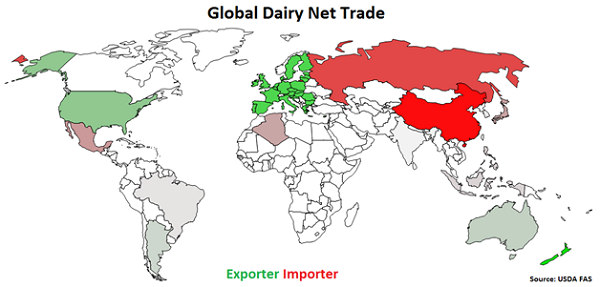 USD/Dairy Exporter FX Index:
The USD/Dairy Exporter FX Index finished higher for the first time in three months during Jun ’16, increasing by 3.0 points to a value of 51.8. The USD/Dairy Exporter FX Index finished at the third highest figure on record and has increased 51.7 points since the beginning of 2014 and 16.0 points throughout the past six months. A strong USD/Dairy Exporter FX Index reduces the competitiveness of U.S. dairy products relative to other exporting regions (represented in green in the Global Dairy Net Trade chart), ultimately resulting in less foreign demand for U.S. products, all other factors being equal. USD appreciation against the Argentine peso has accounted for the majority of the gains since the beginning of 2014.
USD/Dairy Exporter FX Index:
The USD/Dairy Exporter FX Index finished higher for the first time in three months during Jun ’16, increasing by 3.0 points to a value of 51.8. The USD/Dairy Exporter FX Index finished at the third highest figure on record and has increased 51.7 points since the beginning of 2014 and 16.0 points throughout the past six months. A strong USD/Dairy Exporter FX Index reduces the competitiveness of U.S. dairy products relative to other exporting regions (represented in green in the Global Dairy Net Trade chart), ultimately resulting in less foreign demand for U.S. products, all other factors being equal. USD appreciation against the Argentine peso has accounted for the majority of the gains since the beginning of 2014.
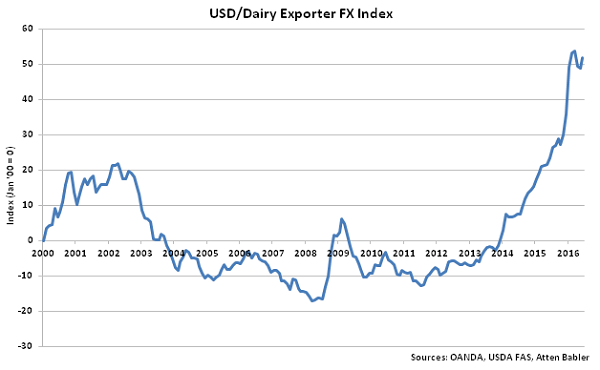 USD appreciation within the USD/Dairy Exporter FX Index during Jun ’16 was led by gains against the Argentine peso, followed by gains against the euro. USD declines were exhibited against the Australian dollar and New Zealand dollar.
USD appreciation within the USD/Dairy Exporter FX Index during Jun ’16 was led by gains against the Argentine peso, followed by gains against the euro. USD declines were exhibited against the Australian dollar and New Zealand dollar.
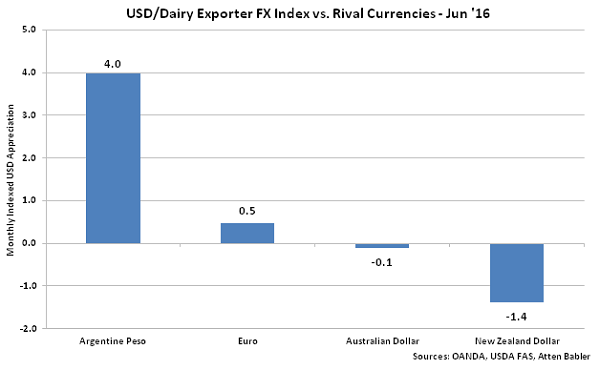 USD/Dairy Importer FX Index:
The USD/Dairy Importer FX Index declined 1.9 points during Jun ’16, finishing at an eight month low value of 40.5. The USD/Dairy Importer FX Index has declined 5.6 points throughout the past six months but remains up 37.0 points since the beginning of 2014. A strong USD/Dairy Importer FX Index results in less purchasing power for major dairy importing countries (represented in red in the Global Dairy Net Trade chart), making U.S. dairy products more expensive to import. USD appreciation against the Russian ruble has accounted for the majority of the gains since the beginning of 2014.
USD/Dairy Importer FX Index:
The USD/Dairy Importer FX Index declined 1.9 points during Jun ’16, finishing at an eight month low value of 40.5. The USD/Dairy Importer FX Index has declined 5.6 points throughout the past six months but remains up 37.0 points since the beginning of 2014. A strong USD/Dairy Importer FX Index results in less purchasing power for major dairy importing countries (represented in red in the Global Dairy Net Trade chart), making U.S. dairy products more expensive to import. USD appreciation against the Russian ruble has accounted for the majority of the gains since the beginning of 2014.
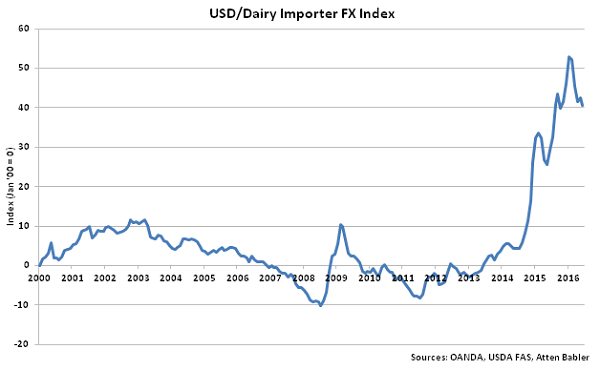 Appreciation against the USD within the USD/Dairy Importer FX Index during Jun ’16 was led by gains by the Russian ruble, followed by gains by the Brazilian real and Japanese yen. USD appreciation was exhibited against the Chinese yuan renminbi and Mexican peso.
Appreciation against the USD within the USD/Dairy Importer FX Index during Jun ’16 was led by gains by the Russian ruble, followed by gains by the Brazilian real and Japanese yen. USD appreciation was exhibited against the Chinese yuan renminbi and Mexican peso.
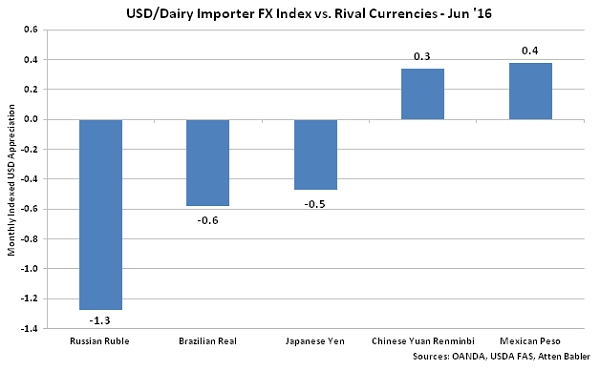 U.S. Dairy Export Destinations:
Major destinations for U.S. dairy exports are led by Mexico, followed by China, Canada, the Philippines and Indonesia.
U.S. Dairy Export Destinations:
Major destinations for U.S. dairy exports are led by Mexico, followed by China, Canada, the Philippines and Indonesia.
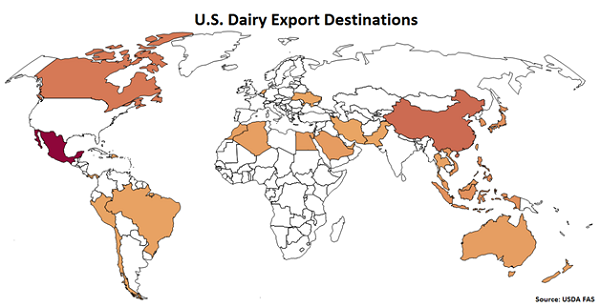 USD/Domestic Dairy Importer FX Index:
The USD/Domestic Dairy Importer FX Index declined 0.2 points during Jun ’16, finishing at a value of 46.7. The USD/Domestic Dairy Importer FX Index remains at the fourth highest figure on record and has increased 27.0 points since the beginning of 2014 and 1.6 points throughout the past six months. A strong USD/Domestic Dairy Importer FX Index results in less purchasing power for the traditional buyers of U.S. dairy products (represented in red in the U.S. Dairy Export Destinations chart), ultimately resulting in less foreign demand for U.S. products, all other factors being equal. USD appreciation against the Mexican peso has accounted for the majority of the gains since the beginning of 2014.
USD/Domestic Dairy Importer FX Index:
The USD/Domestic Dairy Importer FX Index declined 0.2 points during Jun ’16, finishing at a value of 46.7. The USD/Domestic Dairy Importer FX Index remains at the fourth highest figure on record and has increased 27.0 points since the beginning of 2014 and 1.6 points throughout the past six months. A strong USD/Domestic Dairy Importer FX Index results in less purchasing power for the traditional buyers of U.S. dairy products (represented in red in the U.S. Dairy Export Destinations chart), ultimately resulting in less foreign demand for U.S. products, all other factors being equal. USD appreciation against the Mexican peso has accounted for the majority of the gains since the beginning of 2014.
 Appreciation against the USD within the USD/Domestic Dairy Importer FX Index during Jun ’16 was led by gains by the Japanese yen, followed by gains by the Brazilian real and Indonesian rupiah. USD appreciation was exhibited against the Chinese yuan renminbi and Mexican peso.
Appreciation against the USD within the USD/Domestic Dairy Importer FX Index during Jun ’16 was led by gains by the Japanese yen, followed by gains by the Brazilian real and Indonesian rupiah. USD appreciation was exhibited against the Chinese yuan renminbi and Mexican peso.
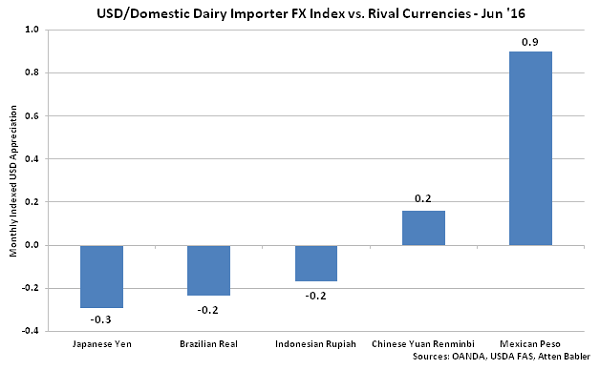
 USD/Dairy Exporter FX Index:
The USD/Dairy Exporter FX Index finished higher for the first time in three months during Jun ’16, increasing by 3.0 points to a value of 51.8. The USD/Dairy Exporter FX Index finished at the third highest figure on record and has increased 51.7 points since the beginning of 2014 and 16.0 points throughout the past six months. A strong USD/Dairy Exporter FX Index reduces the competitiveness of U.S. dairy products relative to other exporting regions (represented in green in the Global Dairy Net Trade chart), ultimately resulting in less foreign demand for U.S. products, all other factors being equal. USD appreciation against the Argentine peso has accounted for the majority of the gains since the beginning of 2014.
USD/Dairy Exporter FX Index:
The USD/Dairy Exporter FX Index finished higher for the first time in three months during Jun ’16, increasing by 3.0 points to a value of 51.8. The USD/Dairy Exporter FX Index finished at the third highest figure on record and has increased 51.7 points since the beginning of 2014 and 16.0 points throughout the past six months. A strong USD/Dairy Exporter FX Index reduces the competitiveness of U.S. dairy products relative to other exporting regions (represented in green in the Global Dairy Net Trade chart), ultimately resulting in less foreign demand for U.S. products, all other factors being equal. USD appreciation against the Argentine peso has accounted for the majority of the gains since the beginning of 2014.
 USD appreciation within the USD/Dairy Exporter FX Index during Jun ’16 was led by gains against the Argentine peso, followed by gains against the euro. USD declines were exhibited against the Australian dollar and New Zealand dollar.
USD appreciation within the USD/Dairy Exporter FX Index during Jun ’16 was led by gains against the Argentine peso, followed by gains against the euro. USD declines were exhibited against the Australian dollar and New Zealand dollar.
 USD/Dairy Importer FX Index:
The USD/Dairy Importer FX Index declined 1.9 points during Jun ’16, finishing at an eight month low value of 40.5. The USD/Dairy Importer FX Index has declined 5.6 points throughout the past six months but remains up 37.0 points since the beginning of 2014. A strong USD/Dairy Importer FX Index results in less purchasing power for major dairy importing countries (represented in red in the Global Dairy Net Trade chart), making U.S. dairy products more expensive to import. USD appreciation against the Russian ruble has accounted for the majority of the gains since the beginning of 2014.
USD/Dairy Importer FX Index:
The USD/Dairy Importer FX Index declined 1.9 points during Jun ’16, finishing at an eight month low value of 40.5. The USD/Dairy Importer FX Index has declined 5.6 points throughout the past six months but remains up 37.0 points since the beginning of 2014. A strong USD/Dairy Importer FX Index results in less purchasing power for major dairy importing countries (represented in red in the Global Dairy Net Trade chart), making U.S. dairy products more expensive to import. USD appreciation against the Russian ruble has accounted for the majority of the gains since the beginning of 2014.
 Appreciation against the USD within the USD/Dairy Importer FX Index during Jun ’16 was led by gains by the Russian ruble, followed by gains by the Brazilian real and Japanese yen. USD appreciation was exhibited against the Chinese yuan renminbi and Mexican peso.
Appreciation against the USD within the USD/Dairy Importer FX Index during Jun ’16 was led by gains by the Russian ruble, followed by gains by the Brazilian real and Japanese yen. USD appreciation was exhibited against the Chinese yuan renminbi and Mexican peso.
 U.S. Dairy Export Destinations:
Major destinations for U.S. dairy exports are led by Mexico, followed by China, Canada, the Philippines and Indonesia.
U.S. Dairy Export Destinations:
Major destinations for U.S. dairy exports are led by Mexico, followed by China, Canada, the Philippines and Indonesia.
 USD/Domestic Dairy Importer FX Index:
The USD/Domestic Dairy Importer FX Index declined 0.2 points during Jun ’16, finishing at a value of 46.7. The USD/Domestic Dairy Importer FX Index remains at the fourth highest figure on record and has increased 27.0 points since the beginning of 2014 and 1.6 points throughout the past six months. A strong USD/Domestic Dairy Importer FX Index results in less purchasing power for the traditional buyers of U.S. dairy products (represented in red in the U.S. Dairy Export Destinations chart), ultimately resulting in less foreign demand for U.S. products, all other factors being equal. USD appreciation against the Mexican peso has accounted for the majority of the gains since the beginning of 2014.
USD/Domestic Dairy Importer FX Index:
The USD/Domestic Dairy Importer FX Index declined 0.2 points during Jun ’16, finishing at a value of 46.7. The USD/Domestic Dairy Importer FX Index remains at the fourth highest figure on record and has increased 27.0 points since the beginning of 2014 and 1.6 points throughout the past six months. A strong USD/Domestic Dairy Importer FX Index results in less purchasing power for the traditional buyers of U.S. dairy products (represented in red in the U.S. Dairy Export Destinations chart), ultimately resulting in less foreign demand for U.S. products, all other factors being equal. USD appreciation against the Mexican peso has accounted for the majority of the gains since the beginning of 2014.
 Appreciation against the USD within the USD/Domestic Dairy Importer FX Index during Jun ’16 was led by gains by the Japanese yen, followed by gains by the Brazilian real and Indonesian rupiah. USD appreciation was exhibited against the Chinese yuan renminbi and Mexican peso.
Appreciation against the USD within the USD/Domestic Dairy Importer FX Index during Jun ’16 was led by gains by the Japanese yen, followed by gains by the Brazilian real and Indonesian rupiah. USD appreciation was exhibited against the Chinese yuan renminbi and Mexican peso.
